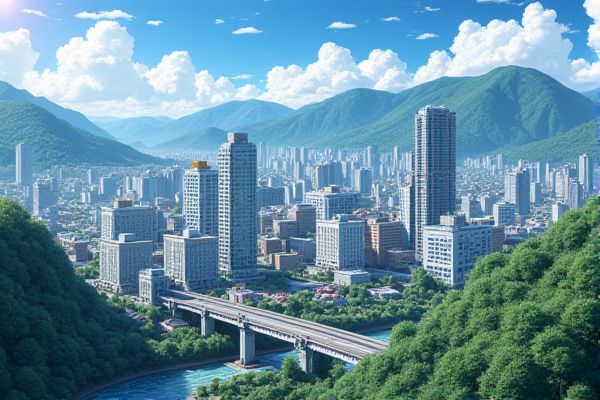
Weather and climate in Japan: Four distinct seasons. Hot, humid summers. Cold, snowy winters in north. Cherry blossoms in spring. Autumn leaves in fall. Typhoon season: June to October. Varying regional climates. Rainy season: June to July. Mild coastal winters. Subtropical conditions in Okinawa.
Four distinct seasons
Japan experiences four distinct seasons: Spring, from March to May, is characterized by mild weather and the stunning cherry blossoms; Summer, lasting from June to August, is marked by intense heat, humidity, and a monsoon season; Autumn occurs from September to November, offering mild temperatures and vibrant fall colors; and Winter, from December to February, features cold temperatures and heavy snow, particularly in the northern regions. The country's climate varies significantly, ranging from subarctic conditions in Hokkaido to subtropical weather in Okinawa. Learn more about the breathtaking Seasons Of Japan and the unique experiences each one offers.
Hot, humid summers
Japan's summer, lasting from June to August, is characterized by extreme heat and high humidity, with daytime temperatures often exceeding 30°C (86°F) and humidity levels ranging from 78% to 83%. The period includes a rainy season in late June and early July, and the hottest months, July and August, can see temperatures as high as 35°C (95°F) and frequent summer rains and typhoons. For more detailed information, visit the Matcha Japan Travel Guide which provides insights and tips for navigating through this intense season.
Cold, snowy winters in north
In Northern Japan, particularly in Hokkaido and the north of Tohoku on Honshu Island, the climate is characterized by a humid continental type with long, harshly cold winters and heavy snowfall, especially on the west-coast regions facing the Sea of Japan. These areas have earned the nickname "snow country" or "Yukiguni." For more in-depth information about the climate and its seasonal patterns, visit their comprehensive website on Climate and Seasons in Japan. This climatic condition significantly influences the lifestyle and culture of the region, marking it with unique seasonal beauty and challenges.
Cherry blossoms in spring
Cherry blossoms in Japan are blooming earlier due to Climate Change and urban warming, with records showing a shift in peak bloom dates by up to 11 days. Concerns are rising that warmer winters may cause some varieties, like the Somei-Yoshino, to face extinction by 2100. For more detailed information, you can explore this topic on The Independent, which provides an in-depth look at the implications of this shift on Japan's iconic cherry blossoms. These changes present a profound impact on cultural traditions and environmental landscapes, highlighting the urgent need to address climate challenges.
Autumn leaves in fall
Autumn leaves in Japan, known as "koyo," typically begin to change colors in mid-September in Hokkaido and from mid-October to early December in other regions such as Tokyo and Kyoto. This year, however, the 2024 season has experienced unusually warm temperatures, resulting in a delay of the peak foliage times. For those planning to visit, cities like Tokyo and Osaka are now expecting their best viewing periods around early December, offering a great opportunity for visitors to witness the vibrant transformation a bit later than usual.
Typhoon season: June to October
Japan's Typhoon Season traditionally runs from June to October, with peak activity between August and September. This period is characterized by powerful tropical storms that can bring strong winds, heavy rainfall, and significant damage, particularly affecting regions like Kyushu, Shikoku, and Okinawa. For travelers planning to visit during these months, it's crucial to stay informed about the weather conditions. Comprehensive information and tips for navigating the typhoon season can be found on the Japan Experience website, which provides valuable insights to ensure a safe and pleasant trip.
Varying regional climates
Japan's climate varies significantly from north to south, ranging from a humid continental climate in the northern region of Hokkaido with cold winters and warm summers, to a subtropical climate in the southern Ryukyu and Nanpo Islands with warm winters and hot, humid summers. The country also experiences different weather patterns between the Pacific coast, which has milder winters and hot summers, and the Sea of Japan side, which is known for heavy snowfall in winter. For more detailed information about Japan, you can visit its Wikipedia page.
Rainy season: June to July
Japan's rainy season, known as Tsuyu or "Plum Rain," typically runs from early June to mid-July, characterized by frequent rain and high humidity due to the collision of cold northerly and warm southerly air masses. This season's start and end dates can vary across different regions, creating diverse climatic patterns throughout the country. For more detailed information on Japan's rainy season, visit this informative blog on Rainy Season Japan.
Mild coastal winters
In Japan, mild coastal winters are typically found along the Pacific Coast, where temperatures rarely drop below 0 degrees, and the region experiences dry and sunny conditions. Especially in Southern Japan, which has a relatively temperate and mild winter. For more detailed insights on this region, you can visit the Expat Guide to Japan and explore its unique climate and geography.
Subtropical conditions in Okinawa
The subtropical climate of Okinawa offers warm winters and hot, humid summers, creating a unique weather pattern for visitors and residents alike. Winters in Okinawa are particularly mild, with minimum temperatures rarely falling below 10 degrees Celsius. This region experiences a distinct rainy season primarily from May to June, which is followed by a prolonged typhoon season that lasts until December. Throughout the year, Okinawa maintains high humidity, while temperatures seldom surpass 35 degrees Celsius. For more detailed insights into the weather patterns and seasons of this beautiful region, you can explore the comprehensive information on All Japan Relocation's website.
